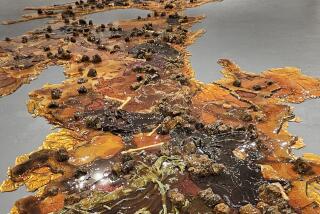Art historian teamed with sculptor spouse
Coosje van Bruggen -- an art historian, writer and curator whose professional partnership with her husband, artist Claes Oldenburg, turned ordinary objects into startling monuments around the world -- died Saturday at her Los Angeles residence. She was 66 and was battling metastatic breast cancer.
Van Bruggen was the author of scholarly books and essays on the work of major contemporary artists including John Baldessari, Bruce Nauman and Gerhard Richter. She also wrote a monograph on architect Frank O. Gehry’s Guggenheim Museum in Bilbao, Spain. But she is best known for collaborations with Oldenburg, which have placed giant trowels, shuttlecocks, bowling pins and typewriter erasers on parklands, civic squares and museum grounds in Europe, Asia and the United States. Cologne, Germany, has its upside-down ice cream cone; San Francisco, its bow and arrow; Denver, its dustpan and broom.
In Los Angeles, “Collar and Bow” -- a 65-foot metal and fiberglass sculpture in the shape of a man’s dress shirt collar and bow tie, designed for a spot outside Walt Disney Concert Hall -- was stalled and eventually canceled because of technical problems and escalating costs. But Van Bruggen and Oldenburg are represented by other public works including “Toppling Ladder With Spilling Paint” at Loyola Law School in downtown L.A. and “Binoculars,” the central component of a commercial building in Venice designed by Gehry.
Born in Groningen, the Netherlands, on June 6, 1942, and educated there, Van Bruggen got her professional start as a curator at the Stedelijk Museum in Amsterdam and a professor at the Academy of Fine Arts in Enschede. Her first work with Oldenburg came in 1976, when she helped him install his 41-foot “Trowel I” on the grounds of the Kroller-Muller Museum in Otterlo.
The Swedish-born American sculptor and draftsman -- who emerged in New York with the Pop movement and became known for his light touch -- and his scholarly Dutch associate might have appeared to be an unlikely match. But their relationship grew into what Oldenburg called “a unity of opposites,” and they were married in 1977.
Van Bruggen, who became a U.S. citizen in 1993, continued to work independently throughout her career. She helped select artists for Documenta 7, the 1982 edition of a prestigious international contemporary art exhibition; contributed articles to Artforum magazine from 1983 to 1988; and served as senior critic in the sculpture department at Yale University School of Art in 1996-97.
As the years passed, she also played an increasingly prominent role in the “Large-Scale Projects” that the couple produced as a team.
Paul Schimmel, chief curator at the Museum of Contemporary Art, who met Van Bruggen in the 1970s, said he was immediately impressed by her seriousness.
“She was among the art historians most respected by artists,” he said Monday. “Thorough and rigorous, she left no stone unturned. She questioned everything. She was admired and, in some ways, feared a little because she didn’t accept any assumption. She was known for her almost scientific approach to looking at an artist’s oeuvre.”
“When she came to the world of creative artists, in collaborations with Claes, she had already developed her way of looking at things,” Schimmel said. “He was playful. He’s a draftsman; he begins with a sensual line. She looked at things with a much more conceptual and systematic approach. Although Claes was clearly well known for his public sculptures prior to their collaboration, I think it was really because of her and what she brought to the partnership that they were able to do so many important public commissions over the last 20 years. She provided a formidable balance to what Claes brought creatively.”
Their collaborative work has been the subject of about 40 exhibitions, including large surveys at MOCA, the National Gallery of Art in Washington, D.C., Museum Ludwig in Cologne and the Hayward and Serpentine galleries in London.
The first piece they created as a team was “Flashlight” (1981), a huge outdoor sculpture at the University of Nevada, Las Vegas.
“Before that,” Van Bruggen told San Francisco critic Kenneth Baker in 2002, “Claes would ask me what I was thinking and I might suggest a few changes. But with the ‘Flashlight,’ the whole sculpture changed at my prompting. That was when we decided either to work together or I would stop commenting.”
Their final joint work, currently being fabricated in Turin, Italy, is “Tumbling Tacks,” designed for the former site of a Norwegian paper mill that has been transformed into the Kistefos Sculpture Park in the countryside north of Oslo. The sculpture will consist of four enormous red, blue and silver tack-like forms, positioned as if they are about to roll down a slope in a forest. The artwork is expected to be installed in May.
Van Bruggen and Oldenburg have been based in New York for many years, but they also lived and worked for extensive periods in Los Angeles and Beaumont-sur-Deme, in the Loire Valley of France.
In addition to her husband, Van Bruggen is survived by her two children from a previous marriage and their spouses, son Paulus Kapteyn and his wife, Sheila, of Jersey City, N.J., and daughter Maartje (who changed her last name to Oldenburg) and her husband, Rustom Khandalavala of London; brothers Jaap van Bruggen of Katete, Zambia, and Dirk van Bruggen of Amsterdam; sister Hanneke van Bruggen Rous of Amsterdam; and grandchildren Thea Kapteyn and Julian Khandalavala.
--
More to Read
The biggest entertainment stories
Get our big stories about Hollywood, film, television, music, arts, culture and more right in your inbox as soon as they publish.
You may occasionally receive promotional content from the Los Angeles Times.










